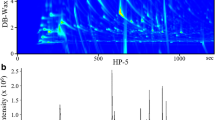Abstract
Urine collected from New World monkeys (tufted capuchin, squirrel monkey, cotton-top tamarin) and Old World monkeys (rhesus macaque, Japanese macaque), was used as the odor stimuli. Two adult tufted capuchins were trained on a successive odor-discrimination task with two odors, 30 trials each, in one session per day. Responses to one of the two odors (S+) were reinforced by sweet water. The monkeys failed to discriminate between the urine from the two species of macaques but could discriminate among the urine from the three species of New World monkeys. Furthermore, similarity of urine odors was analyzed by multi-dimensional scaling (MDS) and a cluster analysis. These analysis suggested that the tufted capuchin can distinguish differences among New World monkeys but not between the macaques. The natural distribution of the tufted capuchin overlaps with that of other New World monkeys, but it does not overlap with those of Old World monkeys. Consequently, it can be concluded that this difference in olfactory recognition in the tufted capuchin reflects their sympatric and allopatric relationships with other species.
Similar content being viewed by others
References
Bailey, K., 1978. Flehmen in the ring-tailed lemur (Lemur catta).Behaviour, 65: 309–319.
Davis, R. G., 1973. Olfactory psychophysical parameters in man, rat, dog and pigeon.J. Comp. Physiol. Psychol., 85: 221–232.
Demaria, C. &J. J. Roeder, 1989. Response to urinary stimuli in pigtailed (Macaca nemestrina) and stumptailed (Macaca arctoides) macaques.Primates, 30: 111–115.
Dooling, R. J., S. D. Brown, T. J. Park, &K. Okanoya, 1990. Natural perceptual categories for vocal signals in budgerigars (Melopsittacus undulatus). In:Comparative Perception, Vol. 2, Complex Signals,W. C. Stebbins &M. A. Barkely (eds.), John Wiley & Sons, New York, pp. 345–374.
Dugmore, S. J., K. Bailey, &C. S. Evans, 1984. Discrimination by male ring-tailed lemurs (Lemur catta) between the scent marks of male and those of female conspecifics.Int. J. Primatol., 5: 235–245.
Epple, G., 1972. Social communication by olfactory signals in marmosets.Int. Zoo Yrbk, 12: 36–42.
—, 1974a. Primate pheromones. In:Pheromones,M. C. Berch (ed.), North Holland, Amsterdam, pp. 366–385.
—, 1974b. Olfactory communication in South America primates.Ann. NY Acad. Sci., 237: 261–278.
—, 1976. Chemical communication and reproductive processes in non-human primates. In:Mammalian Olfaction Reproductive Processes, and Behavior,R. L. Dotty (ed.), Academic Press, New York, pp. 257–282.
—, 1986. Communication by chemical signals. In:Comparative Primate Biology, Vol. 2, Part A,G. Mitchell &J. Erwin (eds.), Alan R. Liss, New York, pp. 531–580.
— &R. Lorenz, 1967. Vorkommen, morphologie und funktion der Sternaldruse bei den Platyrrhini.Folia Primatol., 7: 98–126.
— &D. G. Moulton, 1978. Structural organization and communicatory functions of olfaction in nonhuman primates. In:Sensory Systems of Primates,C. R. Noback (ed.), Plenum Press, New York, pp. 1–22.
Estes, R. D., 1972. The role of the vomeronasal organ in mammalian reproduction.Mammalia, 36: 315–341.
Fujita, K., 1987. Species recognition by five macaque monkeys.Primates, 28: 353–366.
—, 1989. Species recognition in nonhuman primates.Jap. Psychol. Rev., 32: 66–89. (in Japanese with English Summary)
Harcourt, C., 1981. An examination of function of urine washing inGalago senegalensis.Z. Tierpsychol., 55: 119–128.
Harrington, J. E., 1976. Discrimination between individuals by scent inLemur fulvus.Anim. Behav., 24: 207–212.
—, 1977. Discrimination between males and females by scent inLemur fulvus.Anim. Behav., 25: 147–151.
Johnson, S. C., 1967. Hierarchical clustering schemes.Psychometrica, 32: 241–254.
Jordan, J., 1972. The vomeronasal organ (of Jacobson) in primates.Folia Morphol., 31: 418–432.
Kruskal, J. B., 1964. Multidimensional scaling by optimizing goodness of fit to a nonmetric hypothesis.Psychometrica, 29: 1–27.
Mertl, A. S., 1975. Discrimination of individual by scent in primate.Behav. Biol., 14: 505–509.
—, 1977. Habituation to territorial scent marks in the field byLemur catta.Behav. Biol., 21: 500–507.
Mertl-Millhollen, A. S., 1988. Olfactory demarcation of territorial but not home range boundaries byLemur catta.Folia Primatol., 50: 175–187.
Montagna, M. &J. S. Yun, 1962. The skin of primate X: the skin of the ring-tailed lemur (Lemur catta).Amer. J. Phys. Anthropol., 20: 95–117.
Oppenheimer, J. R., 1973. Social and communicatory behavior in Cebus monkey. In:Behavioral Regulators of Behavior in Primates,C. R. Carpenter (ed.), Bucknell Univ. Press, Lewisburg, pp. 251–271.
—, 1977. Communication in new world monkeys. In:How Animals Communicate,T. E. Sebeok (ed.), Indiana Univ. Press, Bloomington, pp. 851–889.
Podgorny, P. &W. R. Garner, 1979. Reaction time as a measure of inter- and intra-object visual similarity: letters of the alphabet.Perception & Psychophysics, 26: 37–49.
Roeder, J. &J. R. Anderson, 1991. Urine washing in brown capuchin monkeys (Cebus apella): testing social and nonsocial hypotheses.Amer. J. Primatol., 24: 55–60.
Schleidt, M., P. Neuman, &H. Morishita, 1988. Pleasure and disgust: memories and associations of pleasant and unpleasant odor in Germany and Japan.Chem. Senses, 13: 279–293.
Slotnick, B. M. &J. E. Ptak, 1977. Olfactory intensity-difference thresholds in rats and humans.Physiol. Behav., 19: 795–802.
Tomonaga, M. &T. Matsuzawa, 1992. Perception of complex geometric figures in chimpanzees (Pan troglodytes) and human (Homo sapience): analyses of visual similarity on the basis of choice reaction time.J. Comp. Psychol., 106: 43–52.
Ueno, Y., 1991. Urine-washing in tufted capuchin (Cebus apella): discrimination between groups by urine-odor. In:Primatology Today,A. Ehara,T. Kimura,O. Takenaka, &M. Iwamoto (eds.), Elsevier, Amsterdam, pp. 297–300.
—, 1994a. Response to urine odor in tufted capuchin (Cebus apella): group discrimination and species discrimination.J. Ethol., 12.
—, 1994b. Olfactory discrimination of eight food flavors in capuchin monkey; comparison between fruity and fishy odors.Primates, 35: 301–310.
Wolfheim, J. H., 1982.Primates of the World: Distribution, Abundance, and Conservation. Univ. of Washington Press, Seattle.
Worhrmann-Repenning, A., 1984. Vergleichend anatomische untersuchungen am vomeronasalkomplex und am rostralen gaumen verschiedener mammalia. Teil I.Gegenbaurs Morph. Jahrb., 130: 501–530.
Yoshikubo, S., 1987. Species discrimination and concept formation by rhesus monkeys (Macaca mulatta).Primates, 26: 285–299.
Ziegler, T. E., G. Epple, C. T. Snowdon, T. A. Porter, A. M. Belcher, &I. Kuderling, 1993. Detection of the chemical signals of ovulation in the cotton-top tamarin,Saguinus oedipus.Anim. Behav., 45: 313–322.
Author information
Authors and Affiliations
About this article
Cite this article
Ueno, Y. Olfactory discrimination of urine odors from five species by tufted capuchin (Cebus apella). Primates 35, 311–323 (1994). https://doi.org/10.1007/BF02382728
Received:
Accepted:
Issue Date:
DOI: https://doi.org/10.1007/BF02382728




